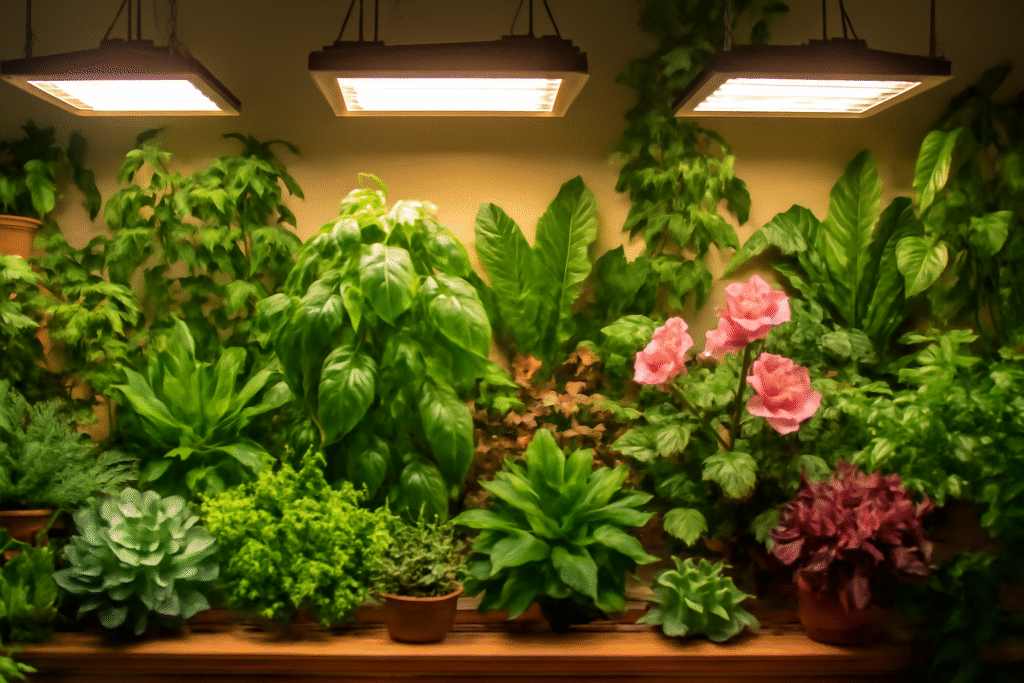
How to Choose the Best Grow Lights for Indoor Plants: A Complete Guide for Thriving Greenery
Are your indoor plants looking a little lackluster despite your best efforts? 
In this guide, we’ll walk you through everything you need to know about choosing the best grow lights for your indoor plants. Whether you’re a beginner or a seasoned plant enthusiast, you’ll learn how the right light can transform your plants from weak and wilted to vibrant and flourishing. Keep reading to discover how the perfect grow light can unlock your plants’ full potential and help them thrive year-round, no matter how much natural sunlight your space gets!
Table of Contents
ToggleWhy Grow Lights Are Essential for Indoor Plants
Indoor plants, while beautiful and rewarding, can be quite picky about their lighting needs. Unlike outdoor plants that bask in the sun, indoor plants often struggle to get enough natural light, especially during the winter months or in homes with limited windows. 
Lack of Natural Sunlight
Most indoor spaces, especially those with limited or no direct sunlight, can’t provide the consistent and intense light that plants need to thrive. Without sufficient light, your plants can become weak, leggy, and lack vibrant color. While some plants are more tolerant of low light, most will need extra light to grow properly.
The Role of Photosynthesis
Just like all living things, plants need food to survive. The process that allows them to make their food is called photosynthesis, which is powered by light. When plants don’t get enough light, they can’t produce enough energy for growth, leading to stunted development and even death. Grow lights simulate the sunlight that plants need to photosynthesize, allowing them to grow strong and healthy, even indoors.
Common Issues Without Grow Lights
- Yellowing Leaves: When plants don’t get enough light, they often show signs of stress, like yellowing or browning leaves. This is one of the most common signs that a plant needs more light.
- Slow Growth: Lack of sufficient light can slow down or even halt a plant’s growth, making it appear stagnant or lifeless.
- Stretching or Leggy Plants: Plants trying to reach for light can grow tall and thin, a condition known as “etiolation.” This not only affects their appearance but can also weaken the plant.
Without the right lighting, your indoor plants may struggle, but with the right grow lights, they can flourish—giving your home a burst of vibrant green all year round.
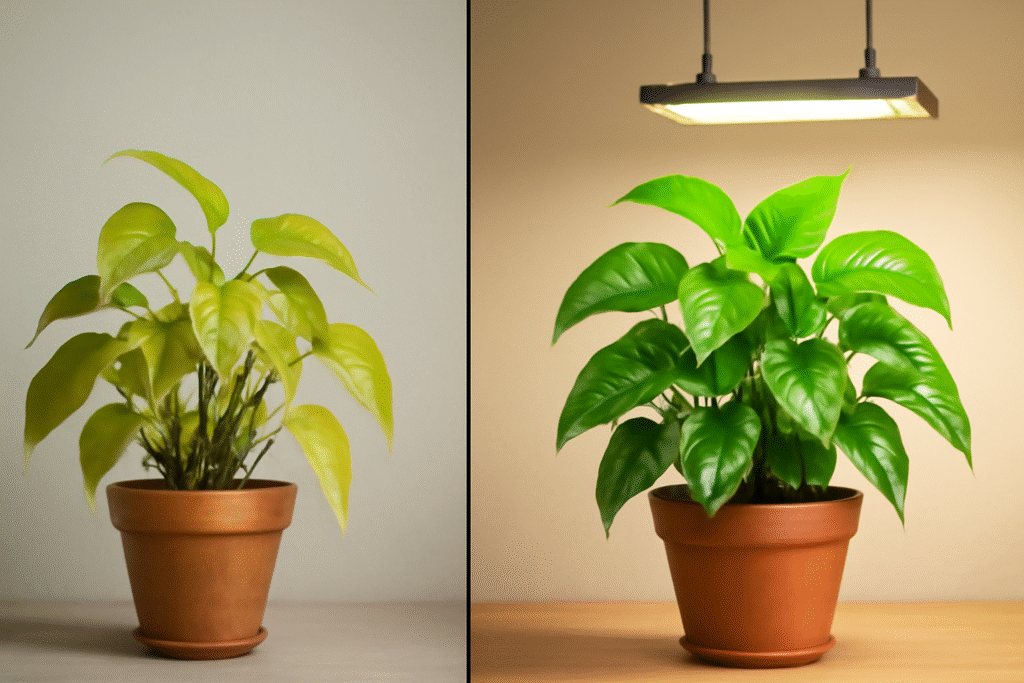
Types of Grow Lights for Indoor Plants
Choosing the right type of grow light is crucial to your plant’s health and growth. There are several types of grow lights, each with its own benefits. Understanding the differences will help you select the best option for your specific plants.
1. LED Grow Lights (Light Emitting Diodes)
LED grow lights are the most popular and widely recommended option. They are energy-efficient, long-lasting, and can be customized to emit specific light spectrums.
- Pros:
- Energy-efficient
: Use up to 60% less energy compared to other types of lights.
- Long lifespan: LEDs last up to 50,000 hours, reducing the need for frequent replacements.
- Full Spectrum
: Many LEDs offer a full spectrum of light, mimicking natural sunlight.
- Low Heat Output: They don’t emit much heat, reducing the risk of burning plants.
- Energy-efficient
- Best for: All types of indoor plants, from succulents to flowering plants.
2. Fluorescent Grow Lights
Fluorescent lights are a cost-effective option, commonly used for seedlings, low-light plants, and plants in need of moderate lighting.
- Pros:
- Affordable
: One of the least expensive types of grow lights.
- Low Heat Emission: Great for plants that require gentle light.
- Efficient: They are relatively energy-efficient.
- Affordable
- Best for: Herbs, leafy greens, and low-light plants like peace lilies or ferns.
3. Incandescent Grow Lights
Incandescent bulbs are the classic light bulbs we all know, but they are less common for plant growth.
- Pros:
- Cheap upfront cost
: Inexpensive to purchase.
- Cheap upfront cost
- Cons:
- Inefficient: They consume a lot of energy and release a lot of heat, which can harm your plants.
- Short lifespan: These bulbs burn out quickly, often within 1,000 hours.
- Best for: Very few plants, typically not recommended for indoor gardening due to their high heat and inefficiency.
4. Halogen Grow Lights
Halogen lights are a type of incandescent bulb but are more energy-efficient and produce brighter light.
- Pros:
- High light intensity
: Great for plants that require intense light.
- Better efficiency: Consumes less power than standard incandescent bulbs.
- High light intensity
- Cons:
- Heat generation
: They emit a lot of heat, which can stress your plants.
- Heat generation
- Best for: High-light plants like succulents and flowering plants.
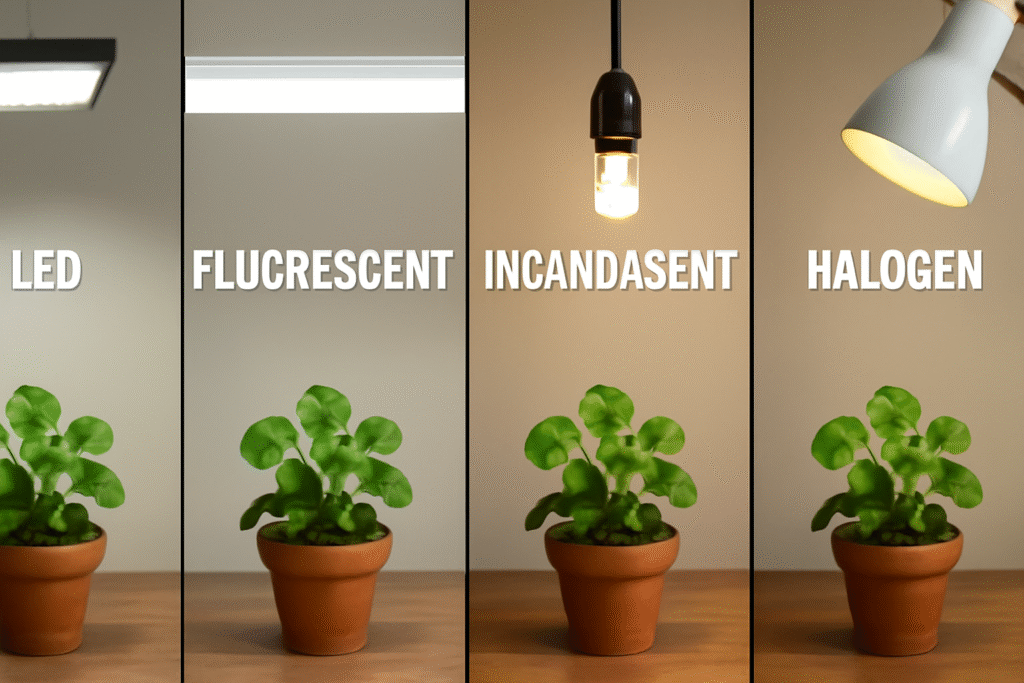
Choosing the Right Light for Your Plant Needs
When choosing a grow light, it’s important to consider factors like plant type, energy efficiency, and heat output. For most indoor plant enthusiasts, LED grow lights are the top choice due to their versatility, energy efficiency, and long lifespan. However, if you’re on a budget, fluorescent lights can also work well for lower-light plants.
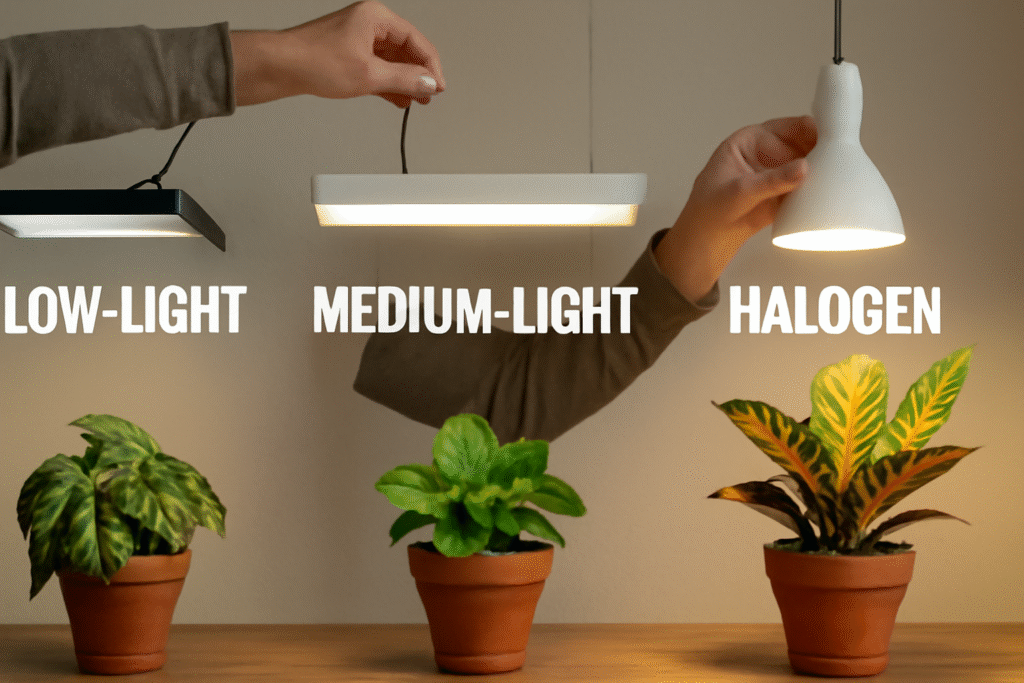
Key Features to Consider When Choosing Grow Lights
When selecting grow lights for your indoor plants, it’s essential to consider certain features that can make a big difference in how your plants thrive. Here’s a breakdown of the key factors to keep in mind.
1. Light Spectrum 
Plants rely on different parts of the light spectrum to support various stages of their growth.
- Red Light: Promotes flowering and fruiting. Essential for plants that bloom or bear fruit, like tomatoes or peppers.
- Blue Light: Encourages strong, healthy leaf growth. Perfect for leafy greens like spinach or lettuce.
- Full Spectrum: A combination of red, blue, and other light wavelengths that mimic natural sunlight. Ideal for a wide variety of indoor plants, from succulents to flowers.
Tip: Choose lights that provide a full spectrum or a mix of red and blue for the most balanced light for your plants.
2. Wattage & Intensity 
The wattage determines how much energy the light consumes, while intensity refers to the strength of the light that reaches your plants.
- Higher Wattage = Stronger Light: More wattage means the light can penetrate deeper into your plant canopy.
- Too much intensity can harm plants, especially those that need low light. For example, a small succulent needs less intensity than a large fern.
Tip: Match the light intensity to your plant’s needs. Low-light plants need less wattage, while sun-loving plants need more.
3. Color Temperature (Kelvin Rating) 
Color temperature measures the warmth or coolness of the light. It’s measured in Kelvin (K), and different temperatures affect plant growth in different ways.
- 5000K to 6500K: Mimics natural daylight, encouraging healthy vegetative growth. Ideal for most indoor plants.
- 2700K to 3000K: Warmer light that’s more suitable for flowering and fruiting stages.
Tip: For general indoor plant growth, opt for lights in the 5000K to 6500K range. If you’re focusing on flowering plants, go for a lower Kelvin range to stimulate blooms.
4. Coverage Area 
Grow lights come in various sizes, so it’s essential to pick one that covers the area of your plants properly.
- Smaller Spaces: A compact light will work well for a small plant collection or a few pots on a shelf.
- Larger Spaces: If you have a lot of plants, you’ll need a light that covers a larger area, or you may need multiple lights to ensure every plant gets adequate light.
Tip: Check the light’s recommended coverage area (usually listed in the product specs) to ensure it fits your space.
5. Adjustability & Flexibility 
Being able to adjust your grow light can make a huge difference in providing the perfect lighting for your plants.
- Height Adjustment: Some lights can be raised or lowered depending on your plant’s growth. This is important as plants grow taller.
- Intensity Control: Look for lights that allow you to control the intensity of the light. This helps avoid stressing your plants with too much light.
Tip: Adjustable lights are perfect for long-term plant growth, as you can tailor the light to different plant stages and conditions.
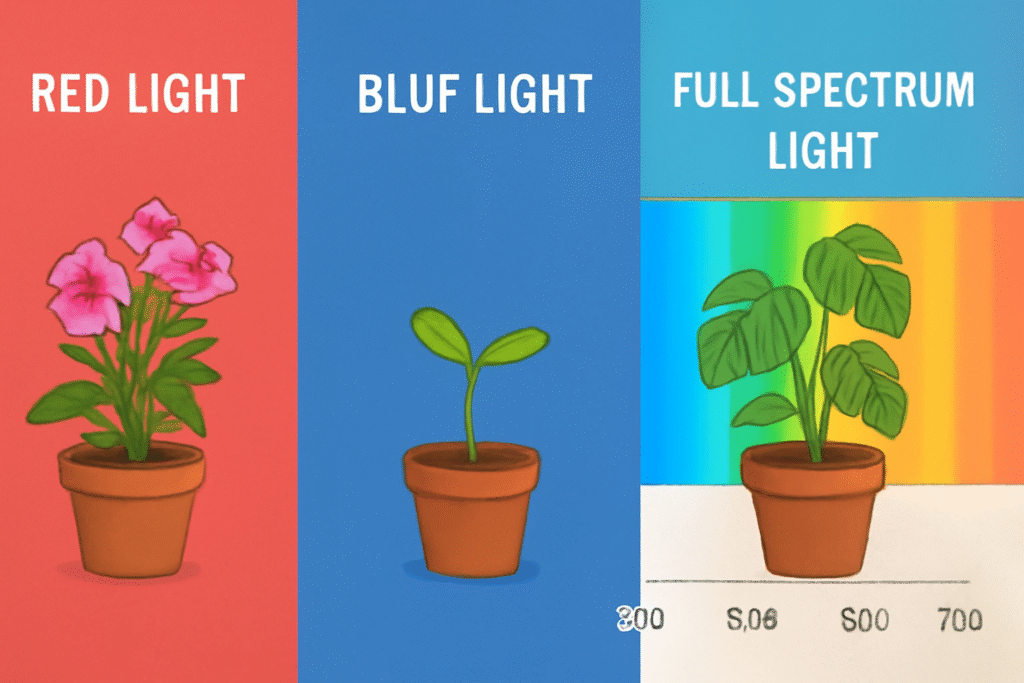
How to Choose the Right Grow Light for Different Types of Plants
Every plant has different light needs, and choosing the right grow light is crucial for helping them thrive. Here’s a simple guide to help you pick the perfect grow light based on your plant’s specific needs.
1. Low-Light Plants 
Low-light plants are great for beginners or spaces with minimal sunlight. These plants can thrive with lower-intensity lights, making them ideal for areas like apartments with limited natural light.
- Examples: Snake Plant, ZZ Plant, Peace Lily.
- Light Needs: These plants don’t require strong light and can do well with fluorescent grow lights or low-wattage LED lights.
- Best Type of Light: Fluorescent or LED grow lights with a lower intensity (around 100-200 watts).
Tip: If your plant is growing slowly or the leaves are yellowing, it might not be getting enough light. Consider increasing the light duration or switching to a slightly brighter light.
2. Medium-Light Plants 
Medium-light plants are more versatile and can adapt to moderate levels of light. They still need consistent light to maintain their health, but they won’t need as much intensity as high-light plants.
- Examples: Pothos, Spider Plant, Ferns.
- Light Needs: These plants thrive in moderate to bright indirect light. LED grow lights with a moderate wattage (around 200-400 watts) work well here.
- Best Type of Light: Full-spectrum LED or fluorescent lights.
Tip: If your medium-light plants are becoming leggy or stretching toward the light source, it’s a sign they may need stronger light or better placement.
3. High-Light Plants 
High-light plants need intense light to grow and flourish. These plants typically come from sunny regions and need lots of light to produce flowers, fruits, or strong foliage.
- Examples: Succulents, Herbs (like Basil), and Flowering Plants (like Geraniums).
- Light Needs: These plants require strong, direct light for 12-16 hours a day. Use high-wattage LED grow lights (400 watts and above) or halogen lights.
- Best Type of Light: High-intensity LED or halogen grow lights that offer strong light output.
Tip: If your high-light plants are not flowering or their leaves are turning pale, they may not be getting enough light. Increase the light intensity or the duration they receive light each day.
4. Flowering & Fruiting Plants 

Plants that bloom or produce fruit need specific light conditions to thrive during their flowering and fruiting stages. These plants benefit from a combination of blue and red light, which promotes both healthy leaf growth and successful flowering.
- Examples: Tomatoes, Peppers, Orchids, and flowering houseplants.
- Light Needs: These plants benefit from a full spectrum of light, with a focus on red and blue wavelengths. Use full-spectrum LED grow lights or specialized lights designed for blooming.
- Best Type of Light: Full-spectrum LED lights or specialized grow lights for flowering plants, typically between 300-600 watts.
Tip: If you notice your flowering plants aren’t producing blooms or fruits, they may need more red light, which stimulates flowering. Consider switching to a light with a stronger red spectrum.
Setting Up Grow Lights for Maximum Effectiveness
Now that you’ve chosen the right grow lights for your plants, it’s time to set them up for optimal growth. The way you position and use your lights can make all the difference in your plant’s health. Here’s a simple guide to ensure you’re setting your grow lights up for maximum effectiveness.
1. Placement of Grow Lights 
The distance between your plants and grow lights is crucial for preventing both underexposure and overheating.
- For Low-Light Plants: Place lights 12-18 inches above the plants. These plants need moderate light, and a greater distance helps avoid stress.
- For Medium-Light Plants: Position lights 6-12 inches away for adequate intensity.
- For High-Light Plants: Keep lights 6-12 inches above the plants for strong, direct light.
- For Flowering Plants: Keep the light closer (6-12 inches) to ensure maximum bloom potential.
Tip: Adjust the height of your grow lights as your plants grow taller. Most grow lights come with adjustable stands or hangers to make this easy.
2. Light Duration (Photoperiod) 
Indoor plants need a consistent day-night cycle to mimic the natural light environment.
- General Rule: Most plants need 12-16 hours of light per day, depending on their growth stage.
- Low-Light Plants: They can thrive with 10-12 hours of light.
- High-Light & Flowering Plants: These plants require longer light exposure (14-16 hours).
Tip: Invest in a timer for your grow lights to maintain a consistent light schedule. This ensures your plants get the right amount of light every day without you needing to remember to turn it on and off.
3. Adjusting Light Intensity 
Some grow lights offer dimming features, allowing you to adjust the intensity based on the needs of your plants.
- For Low-Light Plants: Use a lower light intensity to avoid stressing them.
- For High-Light Plants: These plants need more intense light to thrive, so you can increase the brightness.
- For Flowering Plants: Use higher intensity red light to promote blooming and fruiting.
Tip: Start with a moderate intensity and adjust as needed based on your plant’s response (e.g., if they’re stretching too much, they need more light).
4. Keep Your Plants in a Balanced Environment 
Proper air circulation is just as important as light. When using grow lights, make sure your plants aren’t too hot or too cold.
- Ventilation: Ensure that your plants aren’t exposed to excessive heat. This can cause them to dry out or even burn.
- Humidity: Some plants may need additional humidity, especially when exposed to artificial light. Consider using a humidity tray or a room humidifier for plants that prefer a moist environment.
Tip: If your grow lights generate heat, ensure there’s a small gap between the light and your plants to prevent overheating.
5. Monitor and Adjust Regularly 
Your plants’ needs can change over time as they grow and develop. Periodically check the health of your plants and make adjustments to the light’s distance, intensity, or duration if necessary.
- Signs of Too Much Light: Brown or yellow spots on leaves, crisp edges, or wilting.
- Signs of Too Little Light: Slow growth, leggy plants, or yellowing leaves.
Tip: Keep a close eye on your plants and adjust your setup based on their health. If in doubt, you can always consult the specific needs of your plant species to optimize light conditions.
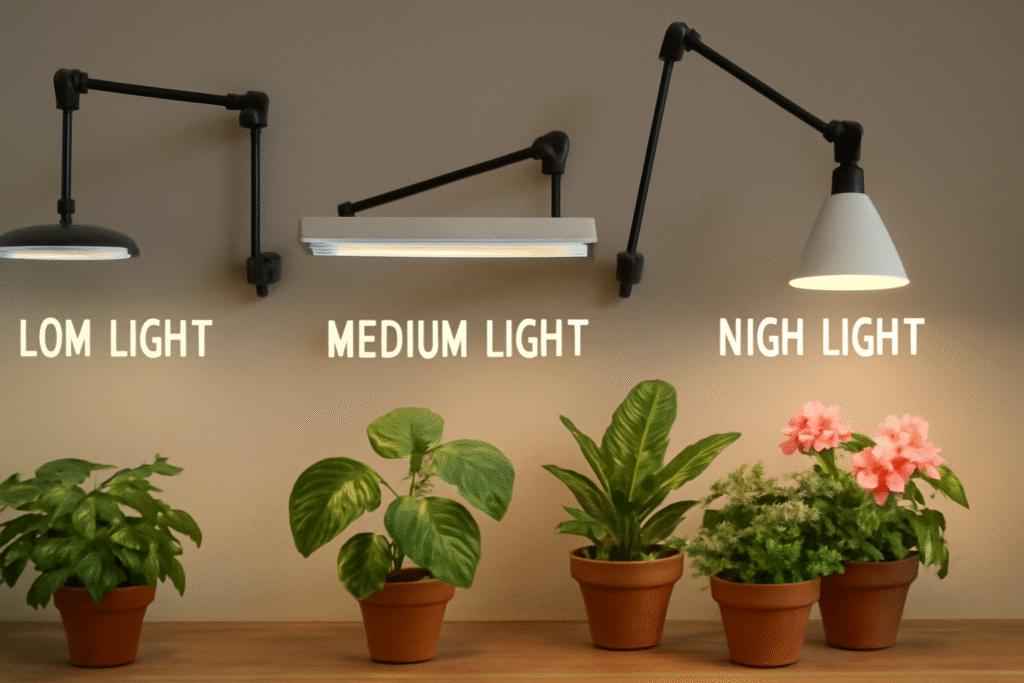
Common Mistakes to Avoid When Using Grow Lights
Even with the best intentions, it’s easy to make mistakes when using grow lights for indoor plants. To help you avoid common pitfalls and ensure your plants thrive, here are some mistakes to steer clear of.
1. Placing Lights Too Close or Too Far 
The distance between your plants and grow lights is one of the most important factors in ensuring your plants receive the right amount of light.
- Too Close: When lights are placed too close, plants can burn or become stressed from excessive heat or intense light.
- Too Far: If the lights are too far away, your plants won’t receive enough light, leading to slow growth and poor health.
Tip: Find the sweet spot by adjusting the height of your lights. For most plants, 6-12 inches is ideal.
2. Not Adjusting Light Intensity 
Not all plants require the same light intensity. Overexposing your plants to intense light or not providing enough can lead to problems.
- Too Much Light: Overexposure can cause leaf burn, brown spots, or wilting.
- Too Little Light: Plants may become leggy, slow-growing, or show yellowing leaves.
Tip: Use dimmable lights or adjust the distance to control light intensity based on your plant’s needs.
3. Ignoring Light Duration 
Every plant has different light needs, and not providing the right light duration can stress your plants.
- Too Little Light: Plants need a consistent day-night cycle. Not giving them enough light can stunt growth.
- Too Much Light: Too long of light exposure can interfere with your plant’s natural rest cycle and cause stress.
Tip: Use a timer to ensure your plants get 12-16 hours of light each day, depending on their needs.
4. Using the Wrong Spectrum 
Each plant requires different light spectrums for various stages of growth. Using the wrong light spectrum can hinder your plant’s health.
- Blue Light: Encourages leaf growth (great for leafy plants).
- Red Light: Essential for flowering and fruiting.
- Full Spectrum: Provides a balanced combination of all wavelengths, best for general growth.
Tip: Choose lights with a full spectrum or select lights with a focus on red and blue, depending on your plant’s growth stage.
5. Not Accounting for Heat Build-Up 
Grow lights, especially incandescent or halogen types, can produce a lot of heat, which may harm your plants.
- Excessive Heat: If lights are too hot or too close, they can dry out your plants or even burn them.
Tip: Make sure your grow lights don’t overheat your plants. If you’re using high-heat lights, increase the distance or opt for cooler LED lights.
6. Forgetting to Clean the Lights Regularly 
Over time, dust and grime can build up on your grow lights, reducing their effectiveness.
- Dust Buildup: Dust can block light, preventing your plants from receiving the full intensity.
Tip: Clean your lights every few weeks to maintain maximum efficiency.
7. Using Inadequate Lighting for Different Growth Stages 

Different plants need different light conditions during various growth stages. Not adjusting your lighting can slow down their progress.
- Seedling Stage: Seedlings need softer, lower-intensity light.
- Vegetative Stage: Stronger light for healthy leaf growth.
- Flowering & Fruiting Stage: Redder light to promote blooms and fruit production.
Tip: Adjust your grow light setup as your plant progresses through different stages. Use a timer and switch between light types as needed.
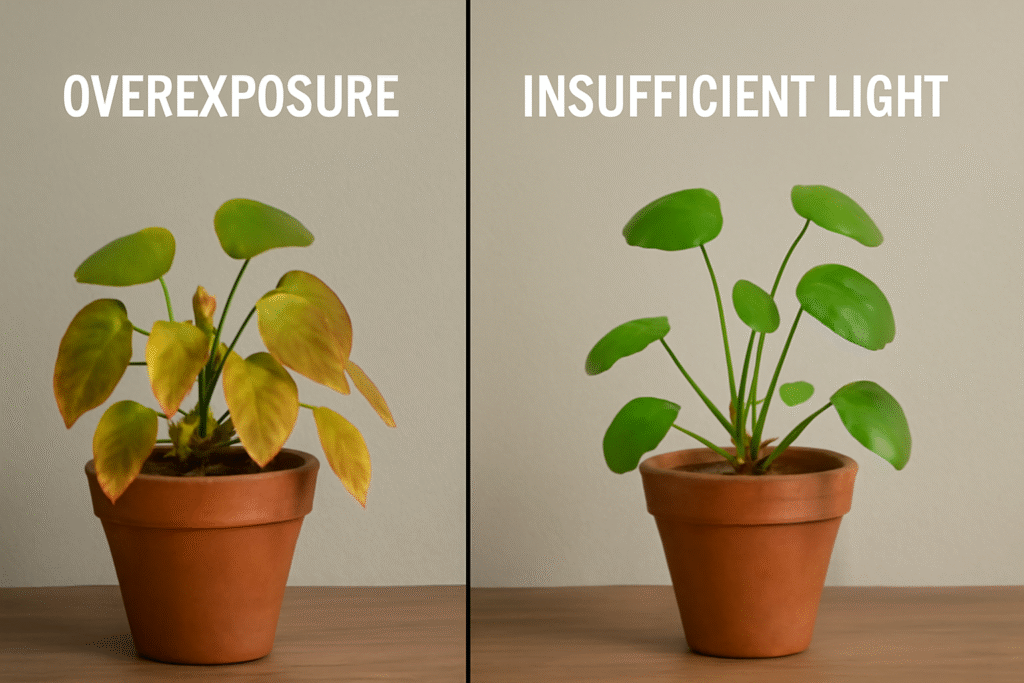
Maintaining Grow Lights for Long-Term Use
To keep your plants thriving and ensure your grow lights remain effective, regular maintenance is key. Here are some simple tips to help you extend the life of your grow lights and keep your indoor garden flourishing.
1. Clean Your Grow Lights Regularly 
Dust and dirt can accumulate on your grow lights, reducing their light output and efficiency. Dirty lights may not provide your plants with the full spectrum of light they need to grow.
- How to Clean: Gently wipe the surface of the bulbs or light panels with a soft, damp cloth. For fixtures with vents, use a small brush or compressed air to remove dust.
- Frequency: Clean your grow lights at least once every 2-3 weeks, or more often if you notice significant dust buildup.
Tip: Always turn off the lights and allow them to cool down before cleaning to prevent any risk of burns or electrical damage.
2. Replace Bulbs When Needed 
Even the best grow lights lose their intensity over time. Fluorescent and incandescent bulbs, in particular, degrade and need to be replaced more frequently.
- LED Lights: These typically last much longer (up to 50,000 hours), but they can still lose some of their effectiveness over time.
- Fluorescent & Incandescent Bulbs: Replace them every 6-12 months, depending on usage.
Tip: Keep track of when you installed the bulbs, and set a reminder to replace them when necessary to avoid a dip in light quality.
3. Check Light Placement Regularly 
As your plants grow, their light requirements may change. You’ll need to adjust the height of your grow lights to ensure they’re still providing the right intensity and coverage.
- High-Growth Plants: Move the light further away to prevent burning.
- Low-Growth Plants: Adjust the light to a closer distance for optimal coverage.
Tip: Monitor your plants’ health—if they seem to be stretching or getting too leggy, it’s time to adjust the light height or intensity.
4. Monitor Temperature & Ventilation 
Excessive heat can damage both your plants and your grow lights. Ensure your grow lights don’t overheat by providing adequate ventilation.
- LED Lights: Produce minimal heat, but check for heat buildup around the fixtures.
- Incandescent & Halogen Lights: These emit more heat, so it’s crucial to maintain a proper distance between the light and your plants.
Tip: Ensure your grow light setup has enough airflow, especially if you’re using high-heat bulbs. A small fan near the lights can help regulate temperature.
5. Keep Your Timer and Settings in Check 
Many indoor gardeners rely on timers to automate their grow light cycles. Over time, the timer or settings may need adjustment, especially if your plants’ needs change or the seasons shift.
- Check Timer Settings: Ensure that your timer is working properly and delivering the right amount of light to your plants.
- Adjust for Seasonal Changes: As daylight hours change, you might need to tweak your light duration for the winter or summer months.
Tip: Test your timer periodically to make sure it’s operating as expected and adjust the duration of light as needed for optimal growth.
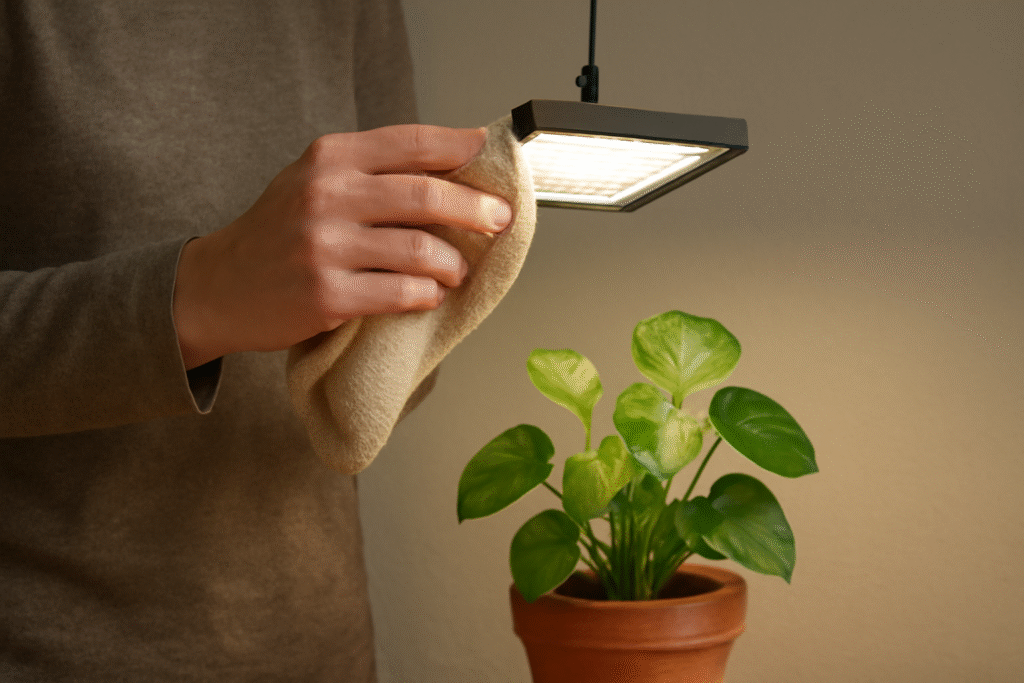
Choosing and maintaining the right grow lights for your indoor plants is key to creating a thriving, vibrant garden. By understanding the different types of grow lights, selecting the right features for your plants, and setting up your lights properly, you can ensure your plants receive the perfect environment for growth—no matter how much natural sunlight your space gets.
Regular maintenance, like cleaning your lights and adjusting their placement, will help keep your setup running smoothly for the long term. With the right care and attention, your indoor plants will not only survive but thrive, adding a touch of green to your home all year round.
Ready to give your plants the light they need to grow strong and healthy? Start by choosing the best grow light today and watch your indoor garden flourish!
Frequently Asked Questions (FAQs)
1. How long should I keep grow lights on for indoor plants?
Most indoor plants need 12-16 hours of light per day. You can adjust the duration based on the plant type—low-light plants need less, while high-light or flowering plants may require more. Using a timer can help maintain a consistent light schedule.
2. Can I use regular lights instead of grow lights?
Regular lights don’t provide the right spectrum of light for plant growth. While they can offer some light, they lack the necessary wavelengths, especially red and blue light, which are essential for photosynthesis and healthy plant growth.
3. What is the best type of grow light for indoor plants?
LED grow lights are generally the best choice. They are energy-efficient, have a long lifespan, and offer a full spectrum of light, making them suitable for a wide variety of plants. They also produce less heat compared to other types.
4. How do I know if my plants are getting too much light?
Signs of too much light include yellowing or brown spots on leaves, curled or scorched edges, and wilting. If you notice these symptoms, try moving your plants further from the light or reduce the light duration.
5. How far should my grow light be from my plants?
The ideal distance varies depending on the light type and plant needs. For most plants, LED lights should be placed 6-12 inches above the plants. If using high-intensity lights, like halogen, you may need to place them further away to avoid heat damage.
6. Can I use grow lights for all types of indoor plants?
Yes, grow lights can be used for nearly all indoor plants. However, the type and intensity of light you choose should depend on your plant’s needs. Low-light plants need less intense light, while sun-loving plants like succulents require stronger light.
7. How often should I replace my grow lights?
LED lights can last up to 50,000 hours, but fluorescent and incandescent lights typically need replacement every 6-12 months. Regularly check your bulbs for reduced intensity or flickering to ensure your plants are getting sufficient light.
8. Do plants need dark periods with grow lights?
Yes, plants need a period of darkness to rest and complete their natural cycles. A consistent day-night cycle (12-16 hours of light followed by 8-12 hours of darkness) is essential for optimal growth, so be sure to turn off your grow lights at night.



